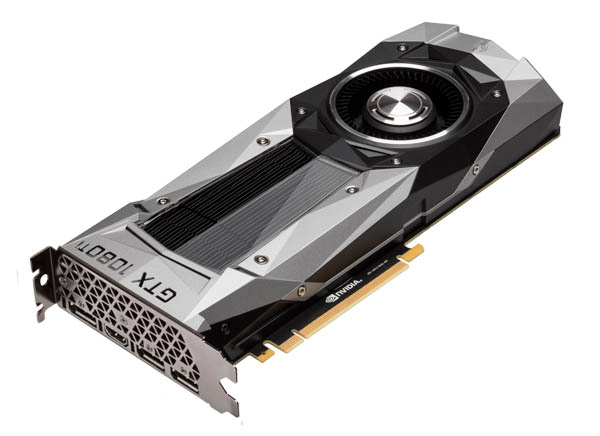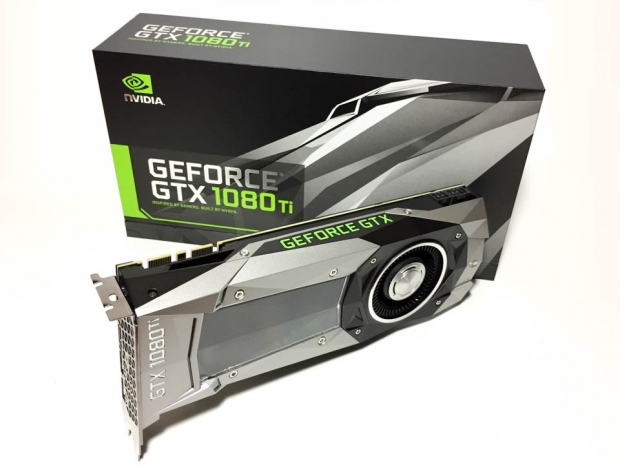Index
- Nvidia Geforce GTX 1080 Ti review
- GPU and memory overview
- Specifications, packaging and hardware overview
- Test Setup
- Results – Nvidia Vulkan API demo
- Results – Cinebench R15
- Results – Civilization VI
- Results – Just Cause 3
- Results – No Man's Sky
- Results – Far Cry 4
- Results – 3DMark + Time Spy
- Results – Unigine Heaven 4.0 Benchmark
- Overclocking
- Conclusion
- All Pages
The most advanced consumer GPU gets over a 40 percent price cut
Nvidia is one of those companies in Silicon Valley that always has one more trick up its sleeve prior to announcing a new roadmap for its consumer and enterprise product lines. In the case of Geforce Pascal, it has now managed to introduce a new flagship that not only surpasses the previous flagship’s performance in every category except for compute (check), but it has also lowered the price by nearly 60 percent.
During the company’s Editors Day event in San Francisco in late February, press and industry representatives were given an inside look into some further architectural improvements and performance tweaks that the company was able to bring to its Geforce GTX 1080, which was previously priced between $599 and $699 depending on the model. Up until this week, that card sat right beneath Titan X Pascal at $1200, but has now been preempted by a new contender in town called the Geforce GTX 1080 Ti. As a result of the new flagship product launch, along with incoming competition from AMD in the form of a new 14-nanometer Vega RX series lineup, Nvidia has now decided that the best approach for attracting professional gamers is not one where the higher-priced product has more performance “weight” than cheaper alternatives, but rather one that adopts supply-side economics – that is, by lowering barriers to the purchase of more premium hardware options. It has now decided to cut the price of the GTX 1080 to $499 in an effort to prepare more PCs for content rich, VR-ready experiences with framerates more closely resembling the panel refresh rates of modern 4K and 5K displays.
As many investors in the industry note, the biggest driver of gross profit margins is usually the competitiveness of products in the marketplace. According to analyst Handel Jones, the cost of producing Nvidia’s 16-nanometer wafers in 2016 was relatively 19 percent cheaper than the cost of producing previous 28-nanometer wafers two years prior. This is likely one reason the company chose to discontinue its Geforce GTX 980 Ti in favor of the GTX 1080 last June. While the Titan X pulled through most benchmarks by a significant margin of at least 15 percent over the GTX 1080, there was at least a $500 price gap between the two cards that was not easily justified for those users not requiring framebuffers above 8GB for their display setups. This gap was also larger than the $350 price gap between the previous GTX 980 Ti and first-gen GTX Titan X in 2014 and 2015. But sure enough, over the course of the past twelve months the gaming industry saw the release of at least two major titles that required framebuffers above this threshold – Watch Dogs 2 and the latest Deus Ex installment. Playing these and similar games at 2160p and higher resolutions has only been possible for those brave enough to invest in at least one or two Titan X Pascal cards, until now.
Geforce GTX 1080 Ti
With the announcement of AMD’s new Vega series on the horizon for Q1 2017, it was only a matter of time before Nvidia was willing to close the price gap between its two topmost cards and bring enthusiast-grade 4K/5K performance to the masses. So late February, it announced the Geforce GTX 1080 Ti at $699, while simultaneously slashing the price of the current GTX 1080 to $499. In addition, it decided to reintroduce the GTX 1080 with an improved 11Gbps GDDR5X memory speed, and reintroduce the GTX 1060 with an improved 9Gbps GDDR5 memory speed. These models will be available within the next couple of weeks.
Since the introduction of Pascal back in April 2016, Nvidia has decided that improvements to power design and efficiency were going to be the forefront of this generation’s product releases. This architecture has brought many performance optimizations including an improved delta color compression engine that not only improves efficiency, but also provides improved overall memory bandwidth. And with the GTX 1080 Ti, the company was able to add even more efficiency using a dualFET architecture for even lower noise distortion. The result is a card that is not only 35 percent faster than the GTX 1080, but over 47 percent faster than the previous generation GTX 980 Ti.




